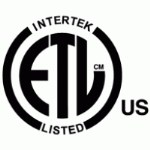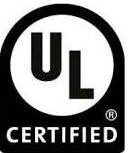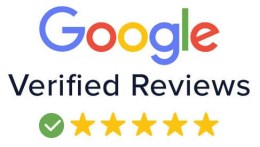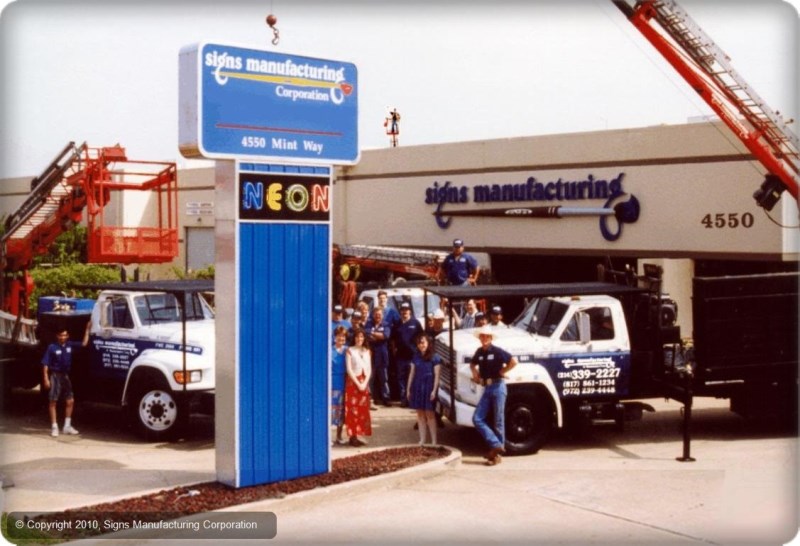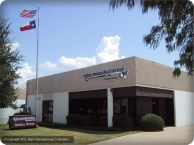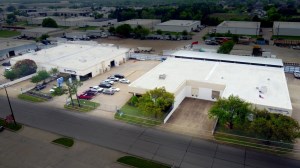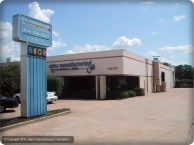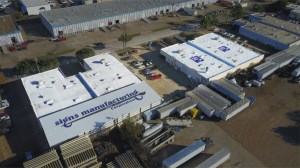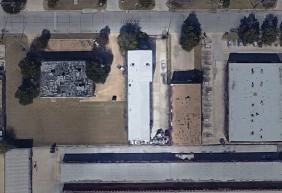Technical Details of LED Signs and Displays Features
4+ Billion Color & 4+ Thousand Shade Monochrome
TURN-KEY LED Sign Manufacturing, Sign Installation, and Sign Service since 1990
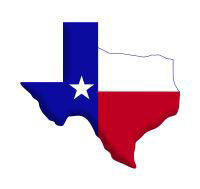 With an electronic message center or video display you are leaving your computer out in the Texas rain, ice, heat and cold, and tornados and hurricane-force winds are trying to blow it away. With an electronic message center or video display you are leaving your computer out in the Texas rain, ice, heat and cold, and tornados and hurricane-force winds are trying to blow it away.
Sunburst Displays™ are Built in Texas by us and we have been building high quality digital signage since we rolled out our first digital sign in 1990!
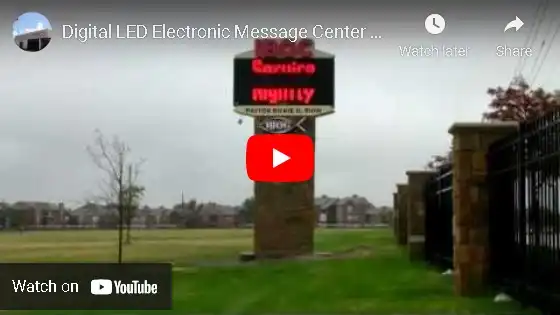
Display Types
Historically, monotone, then monochrome “message centers” were much cheaper than color “video displays.” This is no longer true.
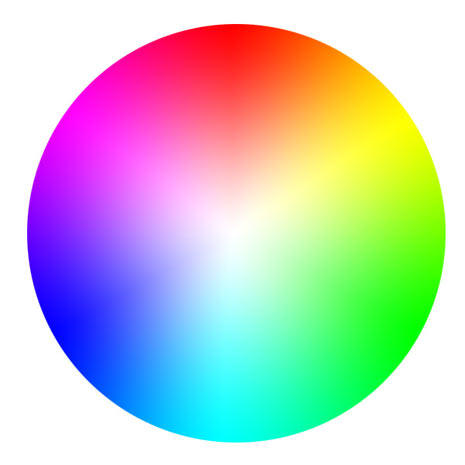 In making your decision regarding monochrome vs. color realize that colors in motion are proven to be much more attention-getting than moving single-color lights. Also, the number of LEDs actually lighted determines how bright a sign is at any particular time. Full-color displays constantly utilize many more LEDs. Monochrome and monotone (one color) displays are either Red or Amber (Yellow.) In making your decision regarding monochrome vs. color realize that colors in motion are proven to be much more attention-getting than moving single-color lights. Also, the number of LEDs actually lighted determines how bright a sign is at any particular time. Full-color displays constantly utilize many more LEDs. Monochrome and monotone (one color) displays are either Red or Amber (Yellow.)
To produce so-called “additive” colors, colors created by light, 3 different color producing LEDs are utilized; Red, Green, and Blue (RGB.) For the human eye, red, green and blue lights close together in varying intensities create white and all other colors. Lack of any light output creates black. (See “Contrast” below.)
Our color video displays feature an almost-infinite number of colors, more than the human eye can discern.
Because the intensity of a LED light can be changed by increasing or decreasing the voltage to it our Monochrome displays can feature 4096 shades of Red, necessary for clear animation and video. They do this by adjusting each individual LEDs light output. Some manufacturers call this "grayscale" but frequently they can only generate as few as 250 shades.
What are Pixels and Potential Pixels?
An electronic message center is in some ways a large computer screen. Each "dot" on the screen is called a "pixel". For your sign, each pixel is actually made up of three or four separate LEDs.
The resolution of the display is determined by how many pixels the sign has.
A potential pixel is a physical point that MAY be incorporated into an image; a currently blank point on the screen that MAY be turned “on” to become a pixel in an image.
There are different types of sign technology: Classic (clusters), Balanced Array™ and SMD.
Classic (Clusters) vs. a Balanced Array™
Cluster displays, such as our Classic series sign, take all three colors in LEDs and group them together to form a pixel. This produces very nice colors and is the best technology available for outdoor use when displaying messages.
A Balanced Array™ sign evenly spaces its LEDs to allow less unlighted area on the sign. This typically results in over 30% more LEDs for the same area and for the same stated resolution. If you're displaying images, such as a concert, the Balanced Array™ option is the way to go. Graphics look crisp and lifelike. However, if you're displaying text and messages this is not the best solution for outdoors.
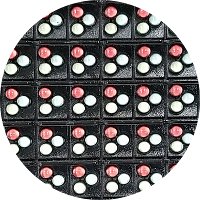 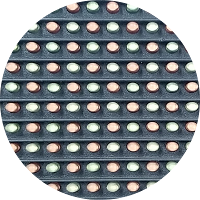
Pixel Density = The Number of Pixels per Square Foot of Sign
A digital sign's "resolution" can be hard to follow because so many things can affect it: spacing of LEDs, spacing of pixels, size of the sign, type of pixels, etc.
As the discussion gets more and more technical, the easiest comparison between displays is the "Pixel Density," the number of LED pixels in a square foot of sign face.
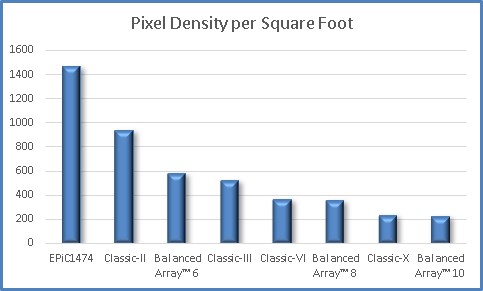
So, as this chart shows, the best resolution sign you can get (for outdoor use) is the EPiC1474. Read below to find out why the EPiC1474 may or may not be right for you.
The Fallacy of “High Resolution” and “HD” in LED Sign Advertising
When competitors talk about all their LED signs being “High Resolution” or “HD” they confuse, rather than assist, consumers. Because an LED sign’s Resolution is totally dependent on the size of the sign they mislead when they promote these catchy marketing terms, possibly causing people to buy signs that cannot meet their needs.
Comparing LED signs to TV’s is “…comparing apples to oranges.”
Billboard signs have either 256 or 362 Pixel Density (19mm or 16mm pixel pitch) for a Resolution of 150,000 to 200,000 pixels. They can look good utilizing a lower Pixel Density only because of their enormous size, and long viewing distance. Viewed from up-close their images are VERY grainy.
Your sign will probably be viewed from much closer than a highway billboard, and be smaller. Your Pixel Density must be much better than theirs to achieve equal Resolution. For instance, even a 6mm Balanced Array™ must be 5’ x 20’ to have approximately the same potential Resolution as a billboard and maintain the same height-to-length ratio, so that identical images can be displayed on them both.
The Critical Importance of Resolution
Smaller signs, lower Pixel Densities, and lower Light Densities are compromises that significantly lessen a sign’s performance, with relatively small cost savings. Your business will be better the higher the Resolution of your sign.
Why Not Use a Television?
TV’s do not have as bright a display as is necessary for outdoor use in full sunlight. We've seen, and tested, claims to the contrary but they never live up to their claims (if they ever did, we would switch over to TVs too!)
Glare on the screen is a big problem. Some companies have "glare-free" screens, but when headlights or parking lot lights are shining on them, there is always significant glare.
Only “specialty” TV’s even claim to be weatherproof.
All modern flat-screen televisions are LCD televisions. So-called “LED” TV’s are actually LCD screens edge or back lighted with LEDs.
Matrix
How many pixels wide and how many pixels high the display is. Matrix determines how many of what size letters can be displayed at one time. Most matrix dimensions are in multiples of 8 pixels, or potential pixel locations in the case of a Balanced Array™ because 8 pixels are necessary to adequately display most letter- styles, so that is how most LED signs are constructed.
A larger matrix (higher Resolution) can display more and/or larger information at one time.
SMD LED Signs (EPiC1474 Series)
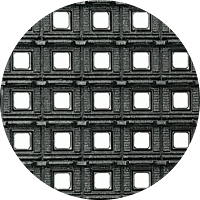 The newest LED development is the “SMD” (Surface-Mount-Device) LED chip. We manufacture signs using them as well. The newest LED development is the “SMD” (Surface-Mount-Device) LED chip. We manufacture signs using them as well.
SMDs are actually 3 very small different colored (RGB) LEDs enclosed in one shell, or lens. The LEDs backlight the translucent shell, which makes the light appear larger. Currently (2023) they are not quite as bright as LEDs, but they still look pretty good.
Don't take our word for it, come see it for yourself in our showroom by looking at our side-by-side comparison. We know a lot of our competitors only sell SMDs and make all kinds of wild claims about them. We highly encourage you to come see for yourself before making that investment.
The strength of SMD signs is that they can pack so many more pixels into a smaller area that the overall look of the sign can outweigh the lighting issue.
Essentially SMD signage is just another type of "pixel cluster" display, but with very small clusters. But each light that creates the pixel is much smaller than a DIP (typical) LED, and it is shielded behind a translucent screen. Consequently, the light is dimmed by having to pass through shell instead of having each LED visible directly.
Grouping many SMDs very closely together can make for a very nice looking indoor display, where the brightness is not as important.
Contrast – Exposed LEDs vs. Enclosed LEDs (SMD)
As with a television, contrast is very important in the legibility of a sign or image. The color “black” plays a very important part in LED image contrast.
Because there is no “black” LED, and because it cannot be created by illuminating other colors in any combination, “black” is the absence of light; all the lights are turned off.
The face design of a LED sign is therefore critical in creating contrast. It must be black, flat, and it cannot be reflective. (See “Glare Shields”.)
This is a problem with SMD (Surface-Mount-Device) LED signs. The SMD’s shell, or lens, is necessary both to protect the circuit-boards and more importantly to make the light source appear larger (above.)
But, because there are actually three very small LEDs inside each SMD, the plastic covering must be translucent white; a black exterior won’t let the light out through the lens! A clear lens won’t spread the light. So when the LED lights are out (above right) the exterior of the face is off-white from a distance, not black, and contrast suffers.
Some manufacturers have developed a smoky black lens to cover the LEDs, instead of using white, with mediocre success. If they ever come up with a good solution, we'll use it. But for now (2018), SMDs just don't have the critically important contrast that is needed for outdoor commercial use.
SMD LEDs work OK indoors, but outdoors where there is an absolute demand for contrast, current SMD LED technology suffers.
How The Shape Of The LED Matters
LEDs are traditionally round. But the LEDs used by Signs
Manufacturing for our LED displays are specifically designed for our use
to create the ideal light output that is needed for an LED sign.
Our purpose-built LED focuses most of the light forward, to the sides, and down. No reason to waste energy shining light on the glare shield above the LED. These
specifically designed LEDs result in brighter signs with more “light-fill” in every image.
Brightness
The “Brightness” of an LED sign is
extremely dependent on the image being displayed. The Red, Green, and Blue (RGB) LEDs are adjusted in light output to create the full spectrum of colors the human eye sees.
Therefore, honestly quantifying a comparative Maximum Light Output (Brightness Potential) of LED signs is tough. Even when varied signs have all their LEDs illuminated 100% the resulting color is not identical. This is because all the Red, Green, and Blue LEDs in LED signs are not the same: in design, sometimes in voltage, in size, in shape, in placement, or in directional light output. Even the numbers of Red, Green, or Blue LEDs in an identical area of sign face are not identical: it varies by display type, and by Light Density. For a manufacturer to say that their signs have the same potential light output is,
at best, baloney.
At Sunburst LED Signs™ we evaluate the “Brightness” of our signs, and our competitors, by taking a foot-candle reading 1 meter from the sign face
using various colors, images, etc. We average the readings for a comparative “real-time” number that means something,
not the “nits” nonsense that so many competitors hang their hat on.
Ask us for details.
Sunburst™ LED Signs are brighter, and remain brighter, because they are designed, powered, cooled, and thermally protected properly.
Automatic Brightness Control
A Sunburst Displays™ electronic message center automatically adjusts its display brightness for the current lighting conditions.
Besides making the display more effective for advertising this feature reduces total electrical consumption and increases component life.
A good LED display that is bright enough to draw attention during the day is too bright at night without Automatic Brightness Control. It's like staring into a flashlight; nothing is readable!
Display Brightness
LEDs are affected by
voltage. For instance, an LED will burn nearly
100% brighter if you double the power feeding it.
The LED will last about 1/6 as long, however, making this
alternative quite expensive in total cost.
LEDs dim as they age. At some point (subjective) they will need to be replaced because they are too dim. Feeding them less voltage extends their useful life.
Superior Sign Faces and Glare Shields
We engineered specialty sign faces and glare shields into our LED sign designs to give our customers even better, safer, longer-lasting signs.
Most competitors just use "plastic louvres" without any consideration
into how they are designed. Ask us for details into what we do to make
our shields ideal for signage.
Determining Your Minimum Display Size
Decide on how many lines of text vertically you need to display. Decide the maximum height of the letters you want each row to use.
Add at least 2” between rows, and 1.25” top and bottom. If you are going to use both upper and lower case letters allow additional space for the descending letters also. The amount of space varies by letter size and style. Will you want a lighted border around your message?
The cumulative total is how tall the minimum display height of your sign must be, in inches.
But, can the display clearly display your smallest letters? For a standard block letter style the smallest letter a 20mm sign can clearly display is a 6.3" tall lower-case character. A 16mm sign can display 5.1" minimum-height characters.
It is possible to go smaller, but it may require some experimentation with letter styles and spacing. Smaller letters probably require a tighter pitched sign.
If you plan on using some lower-case letters recognize that their shorter height is your shortest letter.
Remember that size matters! A larger display will support more detail in images.
Our Sales Representatives can help you determine what size and
resolution you need for your business sign.
|
Desired Minimum
Character Size
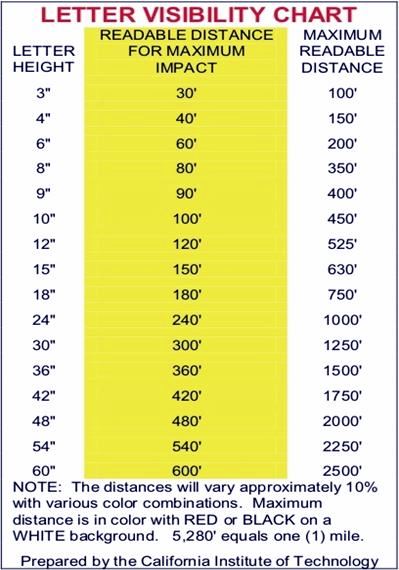
|
Smallest* Recommended Character Size
|
EPiC™ 1474 |
2.1” |
|
Classic™ Series - II |
3.1” |
|
Monochrome Balanced Array™
|
3.1” |
|
6mm Color Balanced Array™
|
3.7” |
|
Classic™ Series - III |
3.7” |
|
Ordinary 12mm Pixel Pitch |
3.8” |
|
8mm Color Balanced Array™
|
4.9” |
|
Classic™ Series - VI |
4.9” |
|
Ordinary 16mm Pixel Pitch |
5.0” |
|
10mm Color Balanced Array™
|
6.2” |
|
Classic™ Series - X |
6.2” |
|
Ordinary 20mm Pixel Pitch |
6.3” |
|
Viewing Distances
The minimum Best Viewing Range is the point at which the display loses significant graininess or color breakdown. Distances can vary depending on the message being displayed.
The maximum viewing distance is the point at which the
smallest character which will be generated on the display
becomes unreadable. A potential solution is to
generate larger characters, but this may increase the
minimum viewing distance.
Best Viewing Ranges
|
EPiC™ 1474 |
10 feet+ |
| Classic™ Series - II |
25 feet+ |
|
6mm Balanced Array™ |
35 feet+ |
| Classic™ Series - III |
40 feet+ |
| Ordinary 12mm Pixel Pitch |
44 feet+ |
| 8mm Balanced Array™ |
45 feet+ |
| Classic™ Series - VI |
50 feet+ |
| Ordinary 16mm Pixel Pitch |
57 feet+ |
| 10mm Balanced Array™ |
55 feet+ |
| Classic™ Series - X |
60 feet+ |
| Ordinary 20mm Pixel Pitch |
70 feet+ |
Reading Time
The length of time letters are readable when moving towards them.
These times are only achievable when viewing signs made with LEDs with wide viewing angles, and a tight Pixel Density.
Many signs reading times are much shorter for the same sized letter.
|
|
|
|
30 MPH |
40 MPH |
60 MPH |
80 MPH |
|
6" LETTERS |
1.4 Seconds |
1 Second |
0.7 Seconds |
0.5 Seconds |
|
|
|
|
|
|
|
8" LETTERS |
1.8 Seconds |
1.4 Seconds |
0.9 Seconds |
0.7 Seconds |
|
|
|
|
|
|
|
12" LETTERS |
3 Seconds |
2 Seconds |
1.5 Seconds |
1 Second |
|
|
|
|
|
|
|
18" LETTERS |
4 Seconds |
3 Seconds |
2 Seconds |
1.5 Seconds |
|
|
|
|
|
|
|
24" LETTERS |
5.5 Seconds |
4 Seconds |
2.75 Seconds |
2 Seconds |
|
|
|
|
|
|
|
36" LETTERS |
8 Seconds |
6 Seconds |
4 Seconds |
3 Seconds |
|
Prepared by Sunburst Displays™ |
Viewing Angles
As an automobile driver drives toward an electronic message center which is installed on a 20’ tall pole the vertical viewing angle increases from near 0° to almost 90° as the driver passes under the sign. As the viewing angle increases the intensity of the display decreases. The vertical viewing angle of the LEDs
used in the display plays an important role in the usefulness of the
display.
It is important to understand the vertical and the horizontal angle that the display will be viewed from.
LED lights are directional, and Glare Shields or Louvers can block visibility.
Some LEDs lose virtually all of their light at angles over 45°. Less-expensive signs must therefore be viewed nearly straight-on to be legible.
Sunburst Displays™ are designed to be effective at radical angles.
The Operating System, and the Internal Controls in a Display
There is a processor or a computer inside digital signs ... in most
systems.
We don't have a
"computer" in our signs.
The very-sophisticated Digital Signage Media Player (DSMP) in our signs
has a non-volatile memory and its sole purpose is to store and control
using the commands you send it from the control-management-system (CMS)
on your programming computer. This vastly superior system also uses
less energy.
Our DSMP stores up to 64
GB of text, images, and video. That is enough memory to change the
image on the sign every second for 723 days! The memory is
non-volatile, no reprogramming after a power failure as is common in
some competitive units.
Poorly engineered signs
are programmed and controlled by a single computer that is hard-wired to
the sign and must be left "on" at all times. Or, in other cheap signs a
second "personal computer" is actually installed inside the sign.
The problem with either
of these systems is that the sign is running on "Windows®"
using a CD or hard-drive and is additionally subject to all the viruses,
freezes, lock-ups and reboot problems that a personal computer faces.
(As an example of the problems faced with a personal computer in the
sign, who climbs the pole of a free-standing pole sign to reboot the
computer after a power outage or computer lock-up? Service call.)
Plus, with all the moving
parts in hard drives, disk drives, and other humidity and temperature
sensitive components, a PC is a poor way to run a sign from inside the
sign. They fail often enough when they are used in the controlled
environment of a building.
Tremendous cooling is
required when there is an "Intel®
Inside" but many of these poorly engineered units don't even have
cooling fans for the LED displays, much less the computer's processor
chip.
Most competitor's signage requires you to use their software, or
their cloud based service, in order to use your sign.
Not ours! Our redundant programming system allows you to program your
sign remotely over the cloud or with a regular laptop and wifi!
Our signage doesn't require our DSMP in order to operate, either! If,
heaven forbid, the DSMP fails and we go out of business,
you can still replace the DSMP with several brands of generic processors
(controllers) and operate your sign. (It won't be as efficient,
versatile, and friendly as our system, but it will work.)
Our
DSMP is wi-fi, internet, and cell-phone capable. Talk to your
Sales Representative for details.
"Our guy who did all the programming for the sign doesn't work here anymore and we can't get into the software to change the message. It has a password and we don't know what it is. I tried calling the company that built it but they're no longer in business!"
Mary Chriswell, Adams Valley Farms
More than any other part of the sign the CMS (Content Management System)
programming software determines the usability of the system.
Most sellers of LED Display signs, whether they manufacture their signs
or import them from China, brag about their "Proprietary" software used
to operate their signs. We don't.
Even
though our key personnel are very comfortable writing computer programs
in several programming languages, we realize that we will never be
smarter than the thousands of Microsoft®
engineers who worked together to create PowerPoint®.
Because of this, we created our open-architecture programming software
designed to use PowerPoint®
to create your animation and messaging; or CorelDRAW®,
or Photoshop®, or any
graphics software you are familiar with.
You already know how to
program the sign because there's no new proprietary programming system
to learn. However, tutorials are a part of our programming.
Proprietary is BAD, not good.
Our CMS programming is quick and easy, and “automatically” brings you
more and more customers, without ANY increase in expenses!
Standard features of our programming software include:
-
Encryption so that no one else can operate the sign
(with current technology it would take 5,389,762 years to crack the
encryption).
-
The programming computer's screen displays exactly what
the sign will look like. Our software automatically enlarges your
graphics and videos to fit the screen, with no additional steps
required.
-
Slides can be created using PowerPoint®,
CorelDRAW®, Photoshop®,
or any graphics software.
-
Text
can be directly entered onto a slide.
-
You can add multiple images at once, speeding set-up time.
-
The programming computer can communicate with the sign
in several different ways to best fit your business (wireless
bridge, wifi, hardwire, cellphone, etc.) Programming access via other
computers, from other locations, using the internet, are all possible. The sign runs on its own internal DSMP
processor.
-
One click updates the sign.
-
Incognito. Our system does not necessarily require
software to be installed on the computers that program our signs, it is
optional. We are not gathering your data to sell as some domestic and
foreign competitors do, which is why they only offer cloud/internet
access.
-
Our system allows for the use of Text, Graphics,
Animation, Slideshow, Video, Scheduling, Time, Temperature, and
Automatic Brightness Control as described individually below.
Do
you know that a .jpg image file automatically adjusts pixel locations as
the image is scaled larger or smaller, to continuously create an image
with smooth edges – not the choppy “building block” look of older image
files (and older LED displays.)
Sunburst’s programming software automatically does this also, to display
the best image possible.
Programming Incorporating the Internet (Websites, etc.)
Sunburst
LED Signs can be programmed to display a portion of your (or anybody's) website
... not just the text and images that you manually program, but anything that
is on the internet, in real time! This greatly expands the opportunities for
your business and can potentially streamline and unify the update process
which may allow your business to get more done with less work!
Typical LED
signs are programmed with software or a cloud service where the user
inputs messages or uploads images then posts them to the sign. If you also
update a website this means double entry. First you upload your message/slides
to your website and then you do the same thing for your LED sign.
But you can
kill two birds with one stone by programming our sign to look at various parts
of your website (you only have to do this once) then you can update your sign by
just changing the message (or images) on the website. Automatically your sign(s)
will also change. This is extremely valuable for businesses that have multiple
signs, although it's useful in a variety of circumstances.
Let's say
you want to display the weather that's listed on a website. Simply tell your
sign to display the X/Y coordinates of that website for, say, 5 seconds. Now
your sign will always have that website's weather reading rotated in with all
the other screens you have created. We show you how to do this as a part of
our training program.
You can also
display feeds like a stock ticker. If your site has a scrolling graphic across
the top that cycles through numbers, like a ticker, you can tell your sign to
display the X/Y coordinates of that graphic and now your sign also has the
ticker on it!
Integrating a programmable digital LED sign with a website offers several other
benefits for a business.
Real-time Updates:
The ability to display a part of a website on the LED sign allows for real-time
updates. Any changes made on the website, such as promotions, announcements, or
live data, can be immediately reflected on the LED sign.
Promotions and Special Offers:
Businesses can use the LED sign to highlight promotions, special offers, or
time-sensitive deals that are featured on the website. This can drive traffic to
the physical location or encourage online engagement.
Enhanced Communication:
Using the LED sign to display website content can serve as an additional
communication channel. Important information, announcements, or event details
can be communicated effectively to a wider audience.
Event Promotion:
Businesses hosting events can promote them on the LED sign in real-time,
directing interested individuals to the website for more details or ticket
purchases.
Time-Sensitive Information:
Displaying time-sensitive information, such as daily specials, event schedules,
or changing product availability, allows businesses to keep customers informed
and engaged.
FREE Computer or Wireless Communication Bridge
For a limited time only, we offer an option to our customer. Either a Wireless Communication Bridge (2 miles line-of-sight
range) for cloud-based programming over your existing computer’s
internet connection, or a FREE laptop with software installed and setup
to work with your sign over WiFi. This option is available with every Sunburst™
LED Sign purchase and our knowledgeable Sales Representatives will
help you determine which is best for you.
What’s Wrong with
most Cloud-Based Programming Systems?
In the
worst of all signs, the CMS software to program the sign is not even in
the sign owner's possession. It is not on a programming computer, it is
"on the cloud" (aka: OneDrive® or Google Drive®.)
The sign must have high-speed internet access, and be “on” 24/7.
Most
competitive cloud-based systems require proprietary programming on the
programming computer. Their purpose is not customer usability. Programs installed on computers, given permission to access the
internet/cloud, can gather and transmit personal data. Be aware that
this is not just signage data, it is anything stored on the computer.
You also need a high-speed internet connection. If internet access is slow, programming is intolerably slow
also. This is especially bad when the cloud server is not in America. A
server in China that hosts cloud based software for operating your sign
in the United States is extremely slow and difficult to use!
What
if the sign manufacturer does not actually own the software? Frequently
they will use a
third-party system which they have to pay for. What happens when they
stop paying for the service?
What happens when they start charging exorbitant prices to YOU
for the service?
Or, what do you do if whoever controls the software on the
cloud goes out of business so your sign cannot be programmed by anyone?
Your sign immediately becomes a very expensive static sign.
Operating and programming software that you both
own, and possess, are definitely in your best interests.
So,
What’s Great About Our Cloud-Based CMS Programming System?
Cloud systems can be great ... if done right. You can
potentially program your sign from any computer, anywhere. It makes
programming your sign easier, getting technical support easier,
automatically updating your software, automatic hardware updates, and
more!
Our LED Signs use a highly encrypted cloud based system for
programming your signs. It is hosted in the United States so it is fast,
easy-to-use, and can be done from anywhere with a computer and an
internet connection.
You are provided all of the login and password information. You are
also provided the actual software so in a worst-case scenario you
can put the software on one of your computers and bypass the cloud
service altogether.
NO competitive signs offer you all of this
versatility.
Computer
Link Types – All 4 Types are Available in Every Sign
Wireless. In all
Sunburst Displays™ a wireless router in the sign is available
to communicate using a wi-fi signal when the programming computer is
attached to a modem. Usually adding an optional wireless
communication “bridge” can solve
range limitation problems.
Hard-wired.
Connection comes from a Cat.5 cable that connects the sign to the
existing network or computer in your building. We strongly recommend
that the Cat.5 cable be installed and connected to your network if
possible. Absolute security.
Cloud-based.
If
Internet is available, a connection can be internally activated in the
sign.
Cellular. Our standard sign design allows
for a cellular Sim card to be added so that the sign has internet access
over available cell towers in instances where the sign is so remote that
internet is not available but cell-phone service is.
Initial Set-Up Options (Set-up and/or
Pre-Programming is usually FREE)
Our customers have the options of on-site programming and/or cloud-based
programming.
If you prefer to program your sign on-site we will provide a FREE laptop
with our CMS programming software pre-installed. Want proof we are not
interested in gathering and selling your data? We offer to install our
programming on this stand-alone computer that does not require internet
or cloud access.
You simply update the sign by connecting to it over WiFi. This is ideal
in situations where the internet is not readily available at that
location. You can create your slides anywhere, they are stored on this
computer, but to publish them to the sign you will need to be within
range of the WiFi signal (see “Wireless” above.)
-or-
We can provide a FREE wireless communication bridge
connection between the sign and your building’s network so that you can
program your sign over the cloud, from anywhere, from any computer,
because our system does not require special programming on the
accessing computer. With the help of your IT Personnel we'll setup
this point-to-point system and connect it to your internet. With this
type of cloud based programming you can create your slides AND publish
them from anywhere. Our SignProgrammer™ cloud system is high-speed,
and based here in the USA, you will not have access problems, or the
time-out error problems Chinese-made cloud-based signs have.
You also receive a link to download our stand-alone
software for personal safekeeping. This ensures that you will always be
able to program the sign directly even without using the cloud, giving
you all the best features of using cloud-based programming but with the
security of owning the software yourself.
Or, for an additional fee, we can provide both
programming options.
What’s Wrong with LED Signs with
Hand-Held Programmers?
These
less-expensive, limited-matrix, limited-color signs won’t present the
best image of you.
-
The signs don’t run video programs; you can
only program wording, and sometimes icons.
-
You have to stand outside in front of the
sign to program it. Rain or snow (etc.)
-
If the control is damaged they are usually
irreplaceable.
Street-Smart™ Marketing Programs Available
In response to some of our customer’s needs, we have created subscription marketing programs
so that you don't have to be marketing savvy, or creative, or even
attentive to the sign.
We'll do it for you!
Our
backgrounds include University-trained graphic arts, business,
marketing, and psychology professionals.
You
can tell us what your goals are for your Sunburst™ LED Sign, and we will
create an effective marketing program for you. We'll handle everything,
including updating it on your sign (still without needing
cloud based or proprietary software.)
Ask for details.
Other Capabilities Of Our LED Signs
-
Enhanced™ Display Mode
-
Text
-
Graphics
-
Animations
-
Slideshows
-
Video
-
Sound (if you have speakers you
would like to attach to it)
-
Live Video or TV Streaming
-
Scheduling (by month, day, time
of day, special occasions, etc.)
-
Double-Sided Programming
-
Display Appearance (with or
without a border around the LEDs)
-
Time / Temperature Display
-
Wired / Wireless / Internet
programming options
-
Superior Ventilation for Texas
heat
-
Front Access for fast, efficient
service
-
Repairability / Adjustability
-
ETL Listed for install anywhere
in the United States
Ask us for details.
The Savings Advantage of a “Listed" Sign
Listed Signs Save You Money.
Sunburst Displays Video Displays and Electronic Message Centers, because they are Listed, are approved to operate with approximately 40% of the power supply requirements of unlisted signs.
This is a huge savings in installation costs, as only 1/3 of the comparable electrical service needs to be provided.
And since the National Electrical Code limits the branch circuits serving signs to 20 amps maximum, this equates to many fewer circuits.
For safety, an untested sign (not Listed) must be supplied with enough electricity to meet the total “continuous” needs of each internal components rating. (Each components rating x 125%)
A Listed sign has been tested as a whole, and the amount of energy actually used has been determined. The sign is approved for use when supplied with this amount of electricity, regardless of the ratings of the individual components.
This is always much less than the rating of each internal component taken individually, so the cost of installing electricity to the sign will be significantly less.
Energy Caveat
Some electronic message center manufacturers
overdrive their LEDs to make them brighter (usually
because they are using inferior LEDs.)
Besides shortening the lifetime of the display to 1/6
of a properly manufactured display, it also wastes energy.
Sunburst Displays™ does not do this.
We do provide internal overvoltage, low voltage, spike and brownout protection for the sign. Many manufacturers do not.
Electromagnetic Interference
Radio Frequency (RF) interference from an electronic sign can cause the sign to interfere with radios, cell phones, radar, TV signals, automatic door openers, hospital equipment, etc.
Radio frequency interference can also cause radios, cell phones, radar, automatic door openers, TV signals, hospital equipment, etc. to interfere with an electronic sign.
Ask us about what we have done to test our signs for EMC and EMI, and what we
have done to keep this from being a problem for you.
The Signs Manufacturing Your-Location Sales Team's
Personalized Service
No matter what types of signs you are interested in, our sales team, consisting of 11 highly-trained individuals, is at your beck and call.
Let us meet with you in your office, or at your new signs location, or home, or anywhere.
You will probably have a firm quotation, not a non-binding "estimate" like most competitors provide, for what you want during our meeting; certainly no more than a day later.
Visit Our Demonstration Showroom
Signs Manufacturing™ built an 85’ by 50’ (over 4,000 sq ft) indoor sign lighting laboratory for testing the longevity, visibility, and effectiveness of all the lighted signs we manufacture.
We have opened our laboratory to the public, for FREE, adding a Sign Showroom that includes LED Video Displays because we realized how important one would be to consumers.
If you are considering purchasing an
LED Video Display or Digital LED Message Center sign this exclusive opportunity will be particularly important. You must determine which display type, and which LED spacing is best, so that your sign will be successful considering how you will use it. Therefore,
6 mm, 8 mm, and 10 mm Balanced Array™ 4+billion-color exposed-LED Video Display signs, Classic™ Series 4+billion-color exposed pixel-cluster LED Video Display signs, and SMD
4+billion-color enclosed-LED Video Display signs are always available for you to compare to monochrome LED message centers or 4-thousand-shade display signs.
If the technical data above confused you, you MUST see the differences between signs in person.
Don't buy your sign from a drawing, a slick website, or photo-shopped pictures,
when you can actually see and
side-by-side compare Real signs and designs.
"I almost made a huge mistake by not listening to you and visiting your showroom prior to buying my sign. I thought I knew what I wanted, after listening to so many salespeople...boy, was I wrong. My vision of the sign did not jibe with what it would really turn out to be, even after viewing so many drawings. It was obvious the moment I entered the showroom. If I had stuck to my guns my sign would have been a disaster. I would have wasted a lot of money."
Cecil Drake, Drake Communications

Free On-Site Demonstrations
Arrange an on-site demonstration today! Demonstrations are available in the Dallas/Fort Worth Metroplex and all of North Texas.
View first-hand the importance of everything we discuss below.
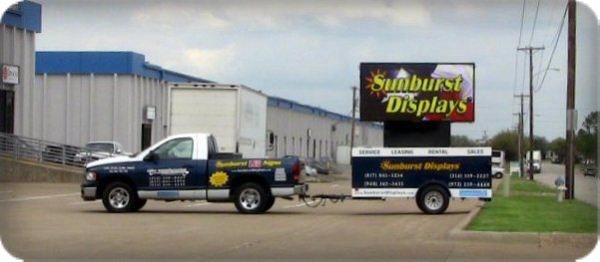
Controlling Message Center Cost
Electronic Message Centers cost a lot of money, but they achieve tremendous results.
To keep from spending more money than necessary, consider the design of your sign and the results you want to achieve.
Rather than purchase a larger, blank, rectangular message center and display your name and all other information on it, consider incorporating signage that constantly displays the messages you want to constantly display. It will cost less, and look better!
Because we manufacture and install all types of signage, not just electronic message centers, we can design, build, and install the most cost efficient and effective signage for you
(see our "Sign Design" page!)
State Licensed Sign Installation and Sign Service
We are a full-service sign company.
We
provide
sign site surveys,
sign permits,
sign installation
and
sign maintenance
services for electrical and non-electrical signs for our customers as well as other sign
companies. We
provide this work in Dallas, Fort Worth (DFW), and ALL of
North Texas and Northeast Texas.
State Sign and Electrical License Numbers: TECL17503, TSCL18015, TSCL18016.
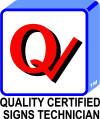 Our technicians are also
Quality Certified Signs™ certified. (Click the "Installation
& Service" tab for details.) Our technicians are also
Quality Certified Signs™ certified. (Click the "Installation
& Service" tab for details.)
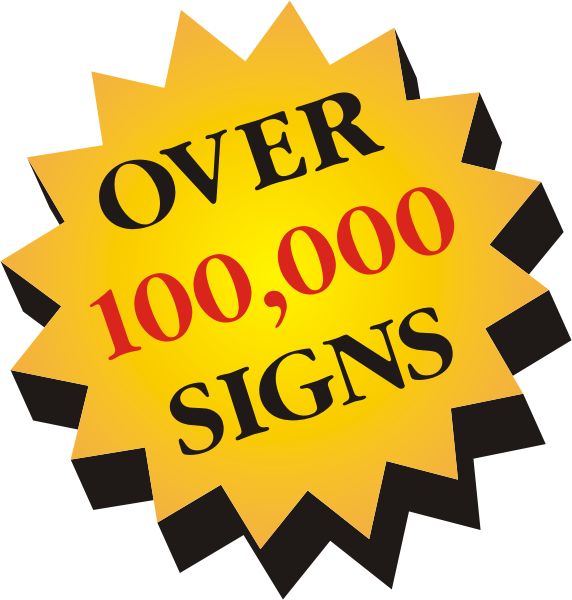 We
serve and have installed signs in the Texas cities of
Addison,
Aledo,
Allen,
Alvarado, Anna, Argyle,
Arlington,
Athens, Aubrey, Avalon,
Azle,
Balch Springs,
Bedford,
Benbrook,
Blue Mound, Bonham,
Briar, Bridgeport,
Buckingham,
Burleson, Caddo Mills, Canton,
Carrollton,
Cedar Hill, Celina,
Cleburne, Cockrell Hill,
Colleyville,
The Colony, Combine,
Coppell,
Corsicana,
Crandall,
Crowley,
Dallas, Dalworthington
Gardens, Decatur,
Denison,
Denton,
Desoto, D/FW Airport, Dido,
Duncanville, Eagle Mountain Lake,
Edgecliff,
Ennis,
Euless,
Everman,
Farmers Branch, Farmersville,
Ferris,
Flower Mound, Forest Hill,
Forney,
Fort Worth,
Frisco,
Gainesville,
Garland,
Glenn Heights,
Granbury,
Grand Prairie,
Grapevine,
Greenville, Gun Barrel
City,
Haltom City,
Haslet,
Highland Park,
Hillsboro, Hudson Oaks,
Hurst,
Hutchins,
Irving, Italy, Itasca,
Jacksboro,
Joshua,
Justin,
Kaufman, Keene,
Keller,
Kennedale, Kleberg, Krum,
Lake Dallas,
Lake Worth,
Lakeside,
Lancaster,
Las Colinas, Lawson,
Lewisville,
Little Elm, Longview,
Mansfield, Marshall,
Maypearl,
McKinney, Melissa,
Mesquite,
Midlothian, Milford,
Mineral Wells, Mount
Pleasant, Mount Vernon,
Murphy,
Nevada, Newark,
North Richland Hills,
Ovilla, Palmer,
Pantego, Paris,
Parker County, Pelican
Bay, Pittsburg,
Plano, Ponder, Princeton,
Prosper,
Quinlan, Quitman,
Red Oak, Rendon,
Richardson,
Richland Hills, Rice,
River Oaks,
Roanoke,
Rockwall,
Rowlett,
Royse City,
Sachse,
Saginaw,
Sansom Park, Sanger,
Seagoville,
Sherman, Silver Creek,
Southlake, Springtown,
Stephenville, Sulphur Springs,
Sunnyvale,
Terrell, Texarkana,
Trophy Club, Tyler,
University Park, Van
Alstyne, Valley View,
Watauga,
Waxahachie,
Weatherford, Wedgewood,
Westlake, Weston,
Westover Hills, Wheatland,
White Settlement, Whitney, Wichita Falls,
Willow Park,
Wills Point,
Wilmer, and
Wylie. We
serve and have installed signs in the Texas cities of
Addison,
Aledo,
Allen,
Alvarado, Anna, Argyle,
Arlington,
Athens, Aubrey, Avalon,
Azle,
Balch Springs,
Bedford,
Benbrook,
Blue Mound, Bonham,
Briar, Bridgeport,
Buckingham,
Burleson, Caddo Mills, Canton,
Carrollton,
Cedar Hill, Celina,
Cleburne, Cockrell Hill,
Colleyville,
The Colony, Combine,
Coppell,
Corsicana,
Crandall,
Crowley,
Dallas, Dalworthington
Gardens, Decatur,
Denison,
Denton,
Desoto, D/FW Airport, Dido,
Duncanville, Eagle Mountain Lake,
Edgecliff,
Ennis,
Euless,
Everman,
Farmers Branch, Farmersville,
Ferris,
Flower Mound, Forest Hill,
Forney,
Fort Worth,
Frisco,
Gainesville,
Garland,
Glenn Heights,
Granbury,
Grand Prairie,
Grapevine,
Greenville, Gun Barrel
City,
Haltom City,
Haslet,
Highland Park,
Hillsboro, Hudson Oaks,
Hurst,
Hutchins,
Irving, Italy, Itasca,
Jacksboro,
Joshua,
Justin,
Kaufman, Keene,
Keller,
Kennedale, Kleberg, Krum,
Lake Dallas,
Lake Worth,
Lakeside,
Lancaster,
Las Colinas, Lawson,
Lewisville,
Little Elm, Longview,
Mansfield, Marshall,
Maypearl,
McKinney, Melissa,
Mesquite,
Midlothian, Milford,
Mineral Wells, Mount
Pleasant, Mount Vernon,
Murphy,
Nevada, Newark,
North Richland Hills,
Ovilla, Palmer,
Pantego, Paris,
Parker County, Pelican
Bay, Pittsburg,
Plano, Ponder, Princeton,
Prosper,
Quinlan, Quitman,
Red Oak, Rendon,
Richardson,
Richland Hills, Rice,
River Oaks,
Roanoke,
Rockwall,
Rowlett,
Royse City,
Sachse,
Saginaw,
Sansom Park, Sanger,
Seagoville,
Sherman, Silver Creek,
Southlake, Springtown,
Stephenville, Sulphur Springs,
Sunnyvale,
Terrell, Texarkana,
Trophy Club, Tyler,
University Park, Van
Alstyne, Valley View,
Watauga,
Waxahachie,
Weatherford, Wedgewood,
Westlake, Weston,
Westover Hills, Wheatland,
White Settlement, Whitney, Wichita Falls,
Willow Park,
Wills Point,
Wilmer, and
Wylie.
ZIP Codes 75001 thru 76958.
Area Codes 214, 254, 430, 469, 682, 817, 903, 940, and
972.
Serving Collin, Cook,
Dallas, Denton, Ellis, Fannin, Franklin, Grayson,
Henderson, Hill, Hood, Hopkins, Hunt, Johnson, Kaufman,
Lamar, Navarro, Parker, Rockwall, Somervell, Tarrant,
Titus, Van Zandt, Wood, and Wise Counties in Texas.
We also have signs in 43 different
states, and 6 other nations.
| 





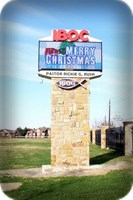
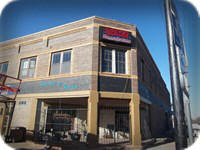
_150.jpg)
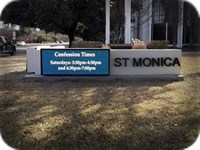
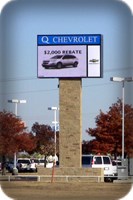
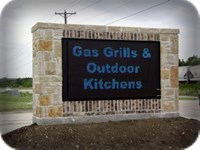
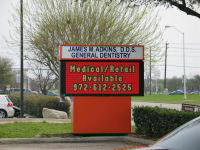
 With an electronic message center or video display you are leaving your computer out in the Texas rain, ice, heat and cold, and tornados and hurricane-force winds are trying to blow it away.
With an electronic message center or video display you are leaving your computer out in the Texas rain, ice, heat and cold, and tornados and hurricane-force winds are trying to blow it away.
 In making your decision regarding monochrome vs. color realize that colors in motion are proven to be much more attention-getting than moving single-color lights. Also, the number of LEDs actually lighted determines how bright a sign is at any particular time. Full-color displays constantly utilize many more LEDs. Monochrome and monotone (one color) displays are either Red or Amber (Yellow.)
In making your decision regarding monochrome vs. color realize that colors in motion are proven to be much more attention-getting than moving single-color lights. Also, the number of LEDs actually lighted determines how bright a sign is at any particular time. Full-color displays constantly utilize many more LEDs. Monochrome and monotone (one color) displays are either Red or Amber (Yellow.)


 The newest LED development is the “SMD” (Surface-Mount-Device) LED chip. We manufacture signs using them as well.
The newest LED development is the “SMD” (Surface-Mount-Device) LED chip. We manufacture signs using them as well.



 We
serve and have installed signs in the Texas cities of
We
serve and have installed signs in the Texas cities of





_medium_110.jpg)

